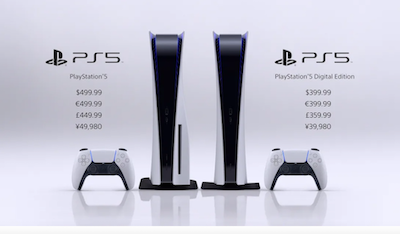Sony and Microsoft Launch the Future of Gaming Consoles This Week
Long-awaited updates PlayStation 5 and Xbox X/S finally hit store shelves
This week, Sony and Microsoft are both launching their first completely new game consoles in seven years. Though the consoles promise to transform gaming for a new generation, that likely won’t happen for a while, given the relative dearth of hot new launch titles available this week.
But the consoles do promise to also sell a lot of high-end monitors and solid-state storage drives, give streaming services potentially huge new distribution opportunities, and provide perhaps the first substantial reason for households to buy an even better 4K TV, capable of the kind of high-frame-rate smoothness that could tickle Peter Jackson’s most ambitious technical fancy.
Those changes began Tuesday, with Xbox releasing its flagship Xbox Series X and low-cost Series S consoles, to be followed Thursday by two flavors of the PlayStation 5, with and without a disc drive.
Also read: Microsoft to Debut Next-Gen Xbox Consoles Nov. 10
In some key ways, the consoles will be relatively similar: To deliver multiplayer games, online commerce, streaming video and internet connectivity, both will rely on Microsoft’s Azure cloud backbone (in a landmark deal between bitter rivals second perhaps only to Richard Nixon going to China).

Both companies’ machines will offer app-based access to high-quality streams from big video and audio services such as Apple’s TV Plus, ViacomCBS’ Pluto, Fox’s Tubi, and Disney’s Hulu.
Both companies’ consoles will deliver much better video quality, up to 4K resolution with six times the refresh rate of a standard HD screen. The $300 Xbox Series S is something of an outlier: it costs less, has no hard drive, is far smaller physically, and maxes out at 1440K resolution, still good enough for tens of millions of TV screens in use today.
NEXT TV NEWSLETTER
The smarter way to stay on top of the streaming and OTT industry. Sign up below.
But that refresh rate on the flagship consoles can look awesome, should you have the monitor or TV screen to actually showcase it. The problem: 4K screens designed to run games at up to 144 Hz, like LG's $1,400 CX TV, aren’t cheap, nor are they common.
The same can be said of smaller desk-top monitors capable of those kinds of specs. A 27-inch, 4K monitor capable of up 144-Hz refresh rates typically runs around $1,000, which is hard to justify for all but the hardest-core PC gamers. With the new consoles, however, a number of manufacturers are jumping in with lower-cost, high-refresh-rate entries, and with 32-inch screens to boot, PC Gamer notes.
Expect the new consoles, and games that push their specs, to help drive broader interest in high-end monitors that could affect all of entertainment.
Microsoft and Sony also tout their console’s use of expandable SSD storage to dramatically speed up the traditionally interminable process of starting up and changing scenes in huge games. Faster storage is not sexy, in any imaginable way, but for frequent gamers, it represents a substantial improvement in quality of life.
The real differentiator between the two sides this time around, however, has less to do with specs and far more with sensibility.
Sony is, perhaps understandably, sticking with the hit-driven exclusives that have made PlayStation the dominant game platform of the last quarter century. Even where it’s sharing a title with PCs, Xboxes and other platforms, Sony often will secure an exclusive window or content to make the game a bit more its own.
By contrast, Microsoft is finally embracing one area where it has competitive advantage: being the maker not just of the Xbox platform but also the software that runs thousands of PC-based games, including most of those used in esports competitions around the planet.
The company’s Game Pass service—which provides cross-platform, free access to a huge library of good games for $15 a month—moves Xbox away from a hit-driven focus and more into the camp of games-as-a-service. Game Pass is a bargain for most gamers, and faces no equal (for now) on the PlayStation 5 side.
More importantly, it updates Xbox for a cloud-gaming era where customers want to play a favored title on whatever device they have, wherever they may be, with friends who may be using different devices.
For those less enamored with the cloud-service approach, several big game franchises are arriving this week, including Ubisoft’s next Assassin’s Creed (Valhalla), Activision Blizzard’s next Call of Duty (Black Ops Cold War), and a significant revamp of Bungie’s Destiny 2.
But lots of other titles aren’t yet ready to launch. Microsoft won’t have the next version of Halo, which almost single-handedly made the original Xbox relevant to gamers two decades ago. It won’t arrive until next year, presumably in time to notably goose sales of this Xbox.
And CD Projekt Red’s hotly awaited Cyberpunk 2077 has been pushed back to December, a victim of the challenges of creating a game for nine platforms, including the new and old consoles.
More generally, it’s clear Microsoft has learned a few lessons since its disastrous launch of the predecessor Xbox One in 2013.
For one thing, this time Microsoft has stripped away whiz-bang peripherals like the Kinect camera that could detect a player’s movements, mood and level of excitement. The tech was cool on the one hand, but also deeply creepy, and boosted the systems’ cost $100, making it uncompetitive with the PS4 in the decisive first months of that generation’s availability. Xbox One never recovered, selling about half as many units as the PlayStation 4 over the time since.
Microsoft has also updated a notoriously clunky interface, which should make it more useful for those trying to find their games, channels and other entertainment.
The bigger challenge for would-be buyers may be finding PlayStation 5 or Xbox Series X/S. Pre-sales quickly wiped available stocks, and now comes time to hunt for outlets that may have a few in store, though limited quantities will make that difficult. But even here, things are different from seven years ago.
Rather than camp out in front of a Best Buy or Game Stop like in days of yore, you’ll be asked to order online, and pick it up when the retailer tells you to, under their pandemic safety protocols. So, maybe it’s a new generation of gaming in ways we never had to imagine before.
David Bloom of Words & Deeds Media is a Santa Monica, Calif.-based writer, podcaster, and consultant focused on the transformative collision of technology, media and entertainment. Bloom is a senior contributor to numerous publications, and producer/host of the Bloom in Tech podcast. He has taught digital media at USC School of Cinematic Arts, and guest lectures regularly at numerous other universities. Bloom formerly worked for Variety, Deadline, Red Herring, and the Los Angeles Daily News, among other publications; was VP of corporate communications at MGM; and was associate dean and chief communications officer at the USC Marshall School of Business. Bloom graduated with honors from the University of Missouri School of Journalism.

